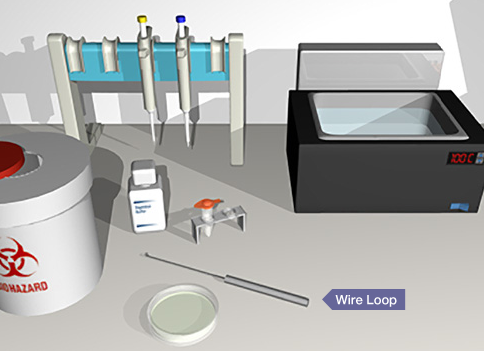Bacterial ID Lab at Howard Hughes Medical Institute
https://www.biointeractive.org/classroom-resources/bacterial-identification-virtual-lab

The procedures necessary for extracting and isolating DNA of an unknown bacteria are costly, time consuming, and can even be dangerous in that it can expose a lab technician to pathogens. Fortunately, technology has given us virtual labs that will show how these procedures are done without the mess and the fuss. In this internet activity, you will use a virtual lab to perform the following procedures:
- Prepare a sample from a patient and isolate whole bacterial DNA.
- Make many copies of the desired piece of DNA.
- Sequence the DNA.
- Analyze the sequence and identify the bacteria
Instructions: The virtual lab is divided into six sections that walk you through the procedures involved. Don't forget to read the notebook section as well, which has further explanation about what you are doing and why. As you complete each section, answer the corresponding questions.
Sample Prep
1. The first step in the extraction process uses a wire loop to do what?
2. Why are the digestive enzymes necessary for DNA extraction?
3. The centrifuge separates the cellular content into two distinct layers. Describe
these layers and what is contained within them.
PCR Amplification
4. What is PCR?
5. What is a primer?
6.
Describe what happens during the 3 cycles
Melt
Anneal
Extend
7. After 30 cycles, how many copies of the initial DNA strand have been produced?
PCR Purification
8. To confirm that the PCR worked, three lanes are run that contain 3 materials. What materials are in the 3 lanes?
Lane 1
Lane 2
Lane 3
9. What is the overall purpose of the purification stage?
Sequencing Prep
10. Describe the “sequencing brew” that you added your purified PCR to.
11. The purpose of the second PCR is not to create identical copies like the first PCR you ran. What is the purpose of this PCR?
DNA Sequencing
12. What is the final PCR product, the stuff contained in your 12 tubes?
13. What is gel electrophoresis?
Sequence Analysis
14. What is BLAST?
15. What is the identity of the bacteria in your sample? Follow the steps listed on the page and be patient. BLAST data can take a while to search.
Other Resources on DNA
Coloring DNA - basic image of DNA and RNA for students to color following directions; includes questions and analysis
DNA Crossword - puzzle to practice basic terms related to DNA
Protein Synthesis Practice - use a codon chart to determine sequences of amino acids
Investigation: DNA Extraction for AP Biology - students extract DNA from different samples and write a lab report; with Claim, Evidence and Reasoning
